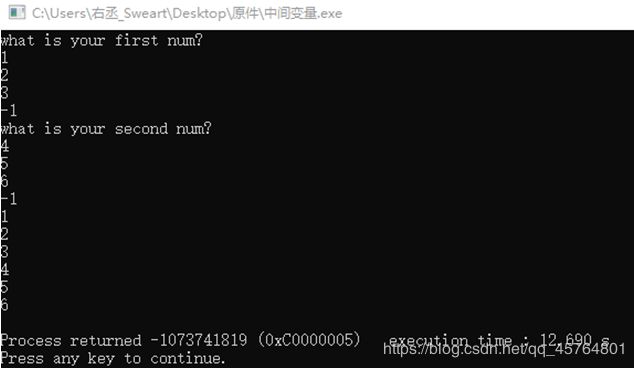C语言程序设计实验第三版:单向链表程序设计
/大家好我是右丞,喜欢和大家一起学习和进步的不怎么的普通人!/
今天也请继续加油!
实验六、单向链表程序设计(p115–p121)
一、实验目的
(1)掌握单向链表的概念和建立方法。
(2)掌握单向链表的基本操作。
二、实验内容
完成C语言程序设计实验与习题指导11.2内容。
1.源程序:
2.调试例子:
3.结果如图:
三、实验程序
1、调试示例
建立学生信息链表:输入若干个学生的信息(学号、姓名、成绩),当输入学号为0
时结束,用单向链表组织这些学生信息后,再按顺序输出。(自建链表)
1.源程序:
#include2.调试例子:
3.结果如图:

2、基础编程题
(1)单向链表建立:输入若干个学生的信息(学号、姓名、成绩),输入学号为0时输入结束,建立一个单向链表,再输入一个成绩值,将成绩大于等于该值的学生信息输出。试编写相应程序。
1.源程序:
#include2.调试例子:
3.结果如图:

(2)逆序数据建立链表:输入若干个正整数(输人-1为结束标志),要求按输人数据的逆序建立一个链表,并输出。试编写相应程序。
1.源程序:
#include2.调试例子:1 2 3 4
3.结果如图:

(3)删除单向链表偶数节点:输入若干个正整数(输人-1为结束标志),建立一个单向链表,将其中的偶数节点删除后输出。试编写相应程序。
1.源程序:
#include2.调试例子:1 2 3
3.结果如图:

(4)链表拼接: 输人若干个正整数 (输入-1为结束标志)建立两个已按升序排序的单向链表,头指针分别为list l、list 2, 把两个链表拼成一个链表,并输出新链表信息。要求自定义函数,实现将两个链表拼成一个链表,并返回拼组后的新链表。试编写相应程序。
1.源程序:
#include2.调试例子:123 -1 456 -1
3.结果如图:

(5)奇数值结点链表:输入若干个整数(输入-1为结束标志)建立一个单向链表,头指针为L,将链表L中奇数值的结点重新组成一个新的链表NEW,并输出新链表的信息。试编写相应程序。
1.源程序:
#include2.调试例子:1 2 3 4 5 6 -1
3.结果如图:

3、改错题
统计专业人数:输入若干个学生的学号(共7位,其中第2、3位是专业号),以“#”作为输入结束标志,将其生成一个链表,统计链表中专业为计算机(编号为02)的学生人数。
1.源程序:
#include2.调试例子:
3.结果如图:

4、拓展编程题
(1)删除结点:输入若干个整数(输入-1为结束标志)建立一个单向链表,再输入一个整数m,删除链表中值为m的所有结点。试编写相应程序。
1.源程序:
#include2.调试例子:1 2 3 4 5 6
3.结果如图:

(2)链表逆置:输入若干个整数(输入-1为结束志)建立一个单向链表,再将链表逆置后输出,即表头置为表尾,表尾为表头。试编写相应程序。
1.源程序:
#include